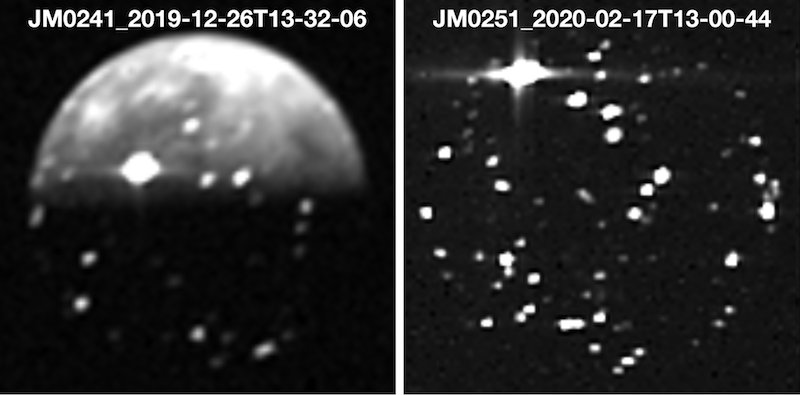Io hot spots detection as revealed by JUNO/JIRAM data
- 1INAF - Istituto di Astrofisica e Planetologia Spaziali, Via del Fosso del Cavaliere, 100, I-00133 Rome, Italy (francesca.zambon@inaf.it)
- 2Planetary Science Institute, 1700 East Fort Lowell, Suite 106, Tucson, AZ, USA
- 3Jet Propulsion Laboratory, 4800 Oak Grove Dr, Pasadena, CA 91109, USA
- 4Agenzia Spaziale Italiana, Via del Politecnico, 00133 Rome, Italy
- 5INAF - Osservatorio Astrofisico di Torino, Via Osservatorio, 20, 10025 Pino Torinese TO
- 6Southwest Research Institute, 6220 Culebra Rd, San Antonio, TX 78238, USA
Io is the Solar System body showing the largest number of active volcanic centers, primarily generated by tidal heating [1]. Many ground based and remote sensing observations have revealed spatial and temporal variabilities, important to define the characteristics of tidal heating and the mechanisms by which heat escapes from the interior [2, 3, 4].
The Jovian Infrared Auroral Mapper (JIRAM), the imager/spectrometer onboard JUNO mission, mainly devoted to the study of Jupiter’s atmosphere, had the opportunity to acquire data of the Galilean satellites, including Io. JIRAM is composed of a slit spectrometer covering a range of wavelengths between 2 and 5 μm and an imager equipped with two filters, L and M, centered at 3.4 and 4.7 μm, respectively [1].
In this work, we mapped the Io hot spots by using JIRAM M filter images from orbits 7, 9, 10, 16, 17, 18, 20, 24, 25, 26, 27, 32, 33, with a spatial scale ranging from ∼ 48 up to ~150 km/pixel (Fig. 1), updating the work by [5]. For each orbit, we consider a set of images (referred to as “super images”) which contain the average radiance of several JIRAM contiguous observations. This approach minimizes the effects due to spurious pixels, reducing the detection of false hot spots [5].
JIRAM data cover almost the entire surface of Io, with a redundancy up to 43 super images per pixel in the northern and equatorial regions (Fig. 2), improving the observations of the polar areas. To identify Io hot spots, we first filtered each super image for emission angles > 75°. Then, since JIRAM data have been acquired at different incidence angles, including Io dayside, nightside, and eclipse (Fig. 1), to select the hot spots, we divided the images in three categories: day (i≤ 70°), dawn/dusk (70° < i < 90°) and night i≥ 90°. For each super image, we calculated the median value of the radiance for the dayside, nightside and dawn/dusk background. Hence, we considered as hot spots’ detection limit the radiance values larger than the median radiance for the night side, and median background radiance plus 0.003 for dawn/dusk and day side.
We identified 242 hot spots, many of which had already been included in other databases (e. g. [6, 7, 8, 9]). Among the hot spots revealed by JIRAM, 24 have not been observed before, and half of these are located at the poles. The comparison between our results and the last Io global heat flow power output map published by [8] suggests that the highest power heat flow hot spots are still active, indicating their activity lasts for decades or more, while a large part of the intermediate power heat flow hot spots are still present, as only 15 of them are not included in our map. We found the larger discrepancies in the lower heat flow hot spots, given that many of those listed as active by [8] have not been observed by JIRAM.
The study of Io hot spots variation and distribution, is worthwhile in helping to constrain the interior models and the magma distribution in its subsurface. The Io hot spots map presented here is the most up-to-date one produced by remote sensing datasets. The future JIRAM higher spatial resolution observations will be fundamental to extend and confirm our results, better distinguish close hot spots and improve our overall knowledge of Io volcanic processes and evolution.

Figure 1: Example of Io JIRAM M filter images for the orbits JM 24 and 25.

Figure 2: JIRAM M filter data coverage of Io for JIRAM orbits 10, 11, 16, 17, 18, 20, 24, 25, 26, 27, 32, 33.
Acknowledgments
This work is supported by Agenzia Spaziale Italiana (ASI). JIRAM is funded by ASI contract 2016-353 23-H.0.
References
[1] Peale, S. J., et al., 1979, Science, 203. [2] Davies et al., 2015, Icarus, 262. [3] de Kleer et al., 2019, The Astronomical Journal, 158. [4] Adriani et al., 2017, Space Science Review, 213. [5] Mura, A., et al., 2020, Icarus, 241. [6] Lopes and Spencer, Eds, 2007, Praxis-Springer. [7] Williams, D. A., et al., 2011, Icarus, 214. [8] Veeder, G. J., et al., 2015, Icarus, 245. [9] Cantrall, C., et al., 2018, Icarus, 312.
How to cite: Zambon, F., Mura, A., Rathbun, J., Lopes, R., Tosi, F., Sordini, R., Noschese, R., Adriani, A., Ciarniello, M., Filacchione, G., Grassi, D., Piccioni, G., Plainaki, C., Sindoni, G., Turrini, D., Brooks, S., Hansen-Koharcheck, C., and Bolton, S.: Io hot spots detection as revealed by JUNO/JIRAM data, Europlanet Science Congress 2022, Granada, Spain, 18–23 Sep 2022, EPSC2022-691, https://doi.org/10.5194/epsc2022-691, 2022.

